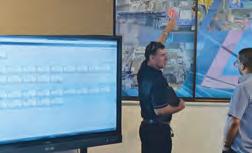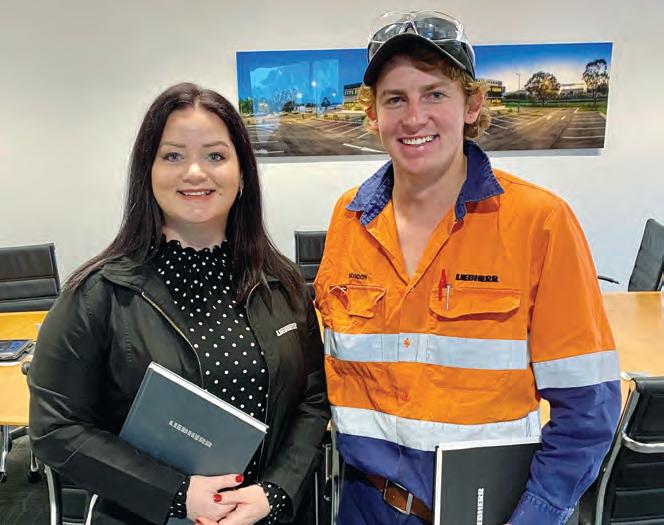
11 minute read
Facing up to adversity
from STW Jul 2021
by Prime Group
Resolve in the face of adversity
DRIVER FATIGUE IS ONE OF THE MOST DANGEROUS RISKS TO WORKER SAFETY ON OUR ROADS. LIEBHERR-AUSTRALIA’S BRANDON ROBINSONSMITH TELLS SAFE TO WORK ABOUT HOW HE TURNED A LIFE-CHANGING EXPERIENCE INTO AN INSPIRING LESSON FOR THE MINING INDUSTRY.
The Japanese proverb Nana korobi, ya oki (fall down seven times, stand up eight) suggests that we should never give up and to continue to push forward in life.
While this could be attributed to many challenges we face every day, Brandon Robinson-Smith has embodied what it means to be persistent when faced with adversity.
In October 2018, he fell asleep at the wheel of his Ford Ranger ute, causing it to lose control and roll off the road just four kilometres from his house.
Robinson-Smith, who was 22 at the time, survived the crash but lost his right arm and suffered a broken pelvis.
“I first started with Liebherr-Australia in February 2018 and worked as a permanent site-based technician at a local coal mine in the Hunter Valley,” Robinson-Smith tells Safe to Work. “What motivated me to work in the mining industry was that I had a bit of a soft spot for working on the diggers.
“It was something that really interested me and being a site technician allowed me to get a bit more experience out of it.”
Robinson-Smith started working with Liebherr-Australia shortly after completing his apprenticeship and, like many young technicians, he was keen to get on the tools when the opportunity was available.
“It was rewarding to learn how to diagnose the machines and point everyone in the right direction through a lot of problem solving,” Robinson-Smith says.
“It was my first night shift of the swing (a block of five nights); I woke up in the afternoon, drove in to start shift at 7pm, worked through to around 7:30am the next morning – all pretty normal stuff.
“After I got home though, I picked up my partner and dropped her off at work, had some breakfast, grabbed some fuel for the car, and started my journey home. I was only four kilometres from my front gate when I fell asleep and lost control.
“I was actually thinking about pulling over to have a rest, as there was a safe spot just after a bridge where I wouldn’t be a hazard to other road users. Unfortunately the sleep came earlier than I would have liked.”
Driver fatigue is one of the three major causes of death on New South Wales roads.
The NSW Centre for Road Safety states that fatigue-related crashes are almost three times more likely to be fatal than crashes not related to fatigue, with on average 67 people dying and 645 seriously injured each year due to fatigue.
Being awake for too long has a similar impact on driving to a blood alcohol content of 0.05 per cent.
Following the accident, RobinsonSmith mustered the willpower to dial 000.
Lyndia Wombold (left) and Brandon Robinson-Smith.
“At the time, I remembered thinking if you nick the artery in your arm, you only have two to three minutes before you can die. As far as I’m concerned, I shouldn’t be here,” he recalls.
Robinson-Smith’s right arm was completely severed during the accident; however, in a macabre but fortunate twist of fate, the artery being severed allowed it to retract in on itself to stop major blood loss. Despite surviving the incident, Robinson-Smith had a long road to recovery ahead.
He was meant to spend 10 weeks in hospital but managed to be discharged after just three, thanks to his determination to recover.
“For the first two weeks in hospital, I was a bit touch and go and being in and out of surgery,” Robinson-Smith says. “I had a total of two surgeries on my hip and two on my shoulder.”
To stop himself from being stuck in a dark place, Robinson-Smith maintained a keen level of mindfulness following the operation.
“While in hospital, I was in a bad spot, but I realised there were people way worse,” he says.
“I always felt that regardless of how bad I was, there was always someone doing it harder than me.”
Robinson-Smith found inspiration for his recovery in a friend who had an accident a few months before his own accident and is permanently in a wheelchair.
“His drive inspired me – I took little bits out of what he did. I’m not much older than he is, and his life was changed far more than mine,” Robinson-Smith says. “So, I pushed myself, I just wanted to get home, get back into it and move on.”
With a fresh perspective, RobinsonSmith accepted the hard truth that his life was going to change drastically and he would need to re-learn the basics.
Being right-handed meant that he was forced to develop skills with his left hand – from writing to cooking.
“It took a bit of time to adjust. I ended up buying a kid’s book, tracing letters to get hand-eye coordination. I’m a lot more comfortable than when I started but it’s not legible,” Robinson-Smith says.
“I couldn’t cook with one arm – things like going to peel potatoes and then realising you can’t even hold the potato to peel it.”
Robinson-Smith says the little things led to frustration with himself. When camping, for example, he couldn’t hold pegs to set up the tent anymore.
“I’d get really angry. Something that I could do by myself so easily after 22 years was gone,” he says.
A big part of Robinson-Smith’s recovery process was taking rehabilitation courses to learn to walk again due to the broken pelvis.
Robinson-Smith married Brittany just a couple of months after the accident. He credits his wife and her brother as the two major support pillars in his life after hospital.
“Brittany stuck by me and told me that everything was going to be all right,” Robinson-Smith says.
“My wife really helped me with pushing me to do things myself rather than relying on her or someone else to do it for me.
“If I complained that something was too hard, she’d encourage me to do it and be there to calm me down if I was getting frustrated.
“I’ve got my support network now and I’m happy to sit and talk about it, but something might hit me. For example, I have a niece and nephew, but I can’t hold them both at once anymore.”
Since the accident, RobinsonSmith has purchased two prosthetics for his right arm, with one being a $200,000 mechanical arm and the other purely aesthetic.
Robinson-Smith says he doesn’t use the mechanical one too often as he has learnt to adapt to using one arm, adding that his motor skills will improve even further as he learns to use the prosthetic.
The emotional pain of losing an arm has also changed Robinson-Smith’s perspective on how disability is perceived in the wider community.
“It was a challenge to get comfortable with how I look now,” he says. “People stare because you look different – and I had to get used to the fact that people are going to stare.
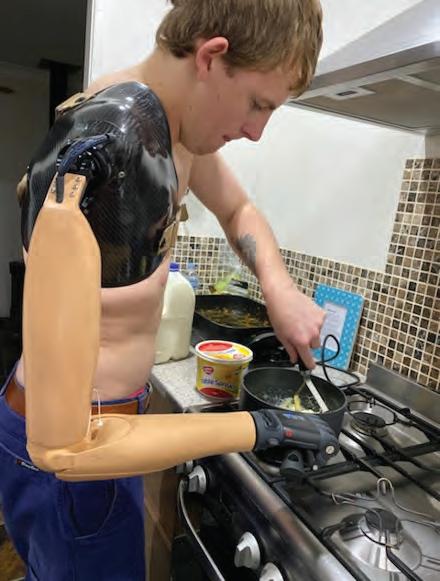
Brandon Robinson-Smith in hospital with Brittany after the accident. Prosthetics are helping with tasks such as cooking.
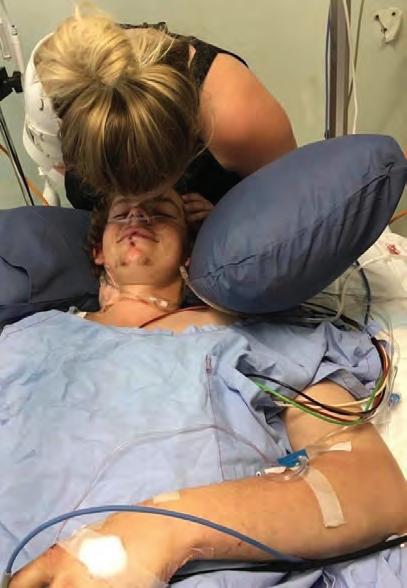
“I dress in a Hawaiian shirt sometimes, just to give them something else to stare at. These days it doesn’t annoy me anywhere near as much, but it still does hurt from time to time.”
The physical pain from the accident is also still present, with ongoing pain remaining. Robinson-Smith says there’s always going to be a phantom pain sensation from where the arm was.
“I might have a pain attack where it feels like the muscles cramping – like touching an electric fence,” he says.
“There’s little things I can do to alleviate the pain, like visualising moving the hand to try and push through it in a virtual sense. Otherwise, I just have to grit my teeth and bear it.
“I was pretty fortunate and strongwilled, I wanted to prove people wrong; this wasn’t going to stop me.”
Workers can struggle to find jobs after suffering a debilitating injury, but this wasn’t a struggle Robinson-Smith had to deal with as an employee of LiebherrAustralia. A role was created addressing business needs to support his return to the workforce.
Liebherr-Australia regional manager NSW customer support, mining, Lyndia Wombold says the priority was to support Robinson-Smith in his recovery, physically and emotionally, and see him return to the team.
“It was important to get him back into his high-vis and back into his work environment. Brandon’s accident affected all of us, especially those colleagues who worked closest with him,” Wombold says.
A counselling service was provided for all employees to access: both at LiebherrAustralia’s Mt Thorley branch, and on the site Robinson-Smith worked at.
“We are a pretty close group and it rattled us, with everyone reflecting on their own and family experiences. Employees visited Brandon providing support, and others kept close to the updates on his recovery,” Wombold says.
While he misses working on diggers, Robinson-Smith says the new role is enjoyable and a good challenge.
“Of course, I find it difficult some days, but I like to keep myself busy and I’m always willing to challenge myself,” Robinson-Smith says.
Wombold says Robinson-Smith has an important and busy role within the service department and is the first to nominate for any extra projects that crop up.
“With his mechanical background, understanding mine site requirements and his ‘get it done’ approach to work, we are fortunate to have an employee of Brandon’s calibre,” Wombold says.
An experience as traumatic as Robinson-Smith’s accident could have left him unwilling to talk about it, but he is instead keen to educate people about the dangers of sleep deprivation.
“I’ve been really passionate about getting the message out, especially to the

Brandon and wife Brittany married months after the accident. mining industry,” he says.
“Liebherr-Australia has been a big help to work alongside to deliver these speeches. I just want to use my voice to make sure no one else has to go through what I did.”
Once Hunter Valley mining customers were aware of Robinson-Smith’s story and how hearing it impacted the Liebherr-Australia employees at Mt Thorley, he was invited to speak at customer safety meetings.
Senior site managers and superintendents attended, along with the workforce, all of which have thanked Robinson-Smith and Liebherr-Australia for sharing his story.
Raising awareness about sleep deprivation is something Robinson-Smith hopes will make a difference by teaching workers about the subtle signs that show they’re too tired to drive.
“Prior to the accident, the danger of sleep deprivation was there but it wasn’t always obvious,” Robinson-Smith says.
“We’ve all sat through sleep deprivation talks but it’s always someone from outside the industry – you find that you don’t really pay attention that much as our experiences are so different. My experience is so typical of our workers that they can easily imagine themselves in my position.”
Almost three years after the accident, Robinson-Smith continues to move forward. He feels fortunate that he has been able to mentally let go of the incident and not hold on to what happened.
“I just keep resetting and start going again. The six months I had off work gave me time to think and I was pretty down for a fair while,” Robinson-Smith says.
“Life will throw you a hurdle but it doesn’t matter how big that hurdle is. As long as you’ve got a positive mindset and a supportive network anything is possible.”
Solutions for enhancing Productivity, Equipment Maintenance, Damage Control, Cost- downs & mitigating OH&S
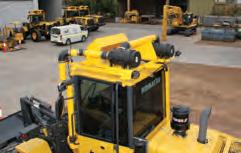
RESPA® / QCABAIR® CABIN / ENCLOSURE FILTRATION & PRECLEANER
Avoid expensive HVAC component failure, choked Evaporators in Cabins and dust in Electrical Enclosures. RESPA® Cabin Pressuriser / Filtration Technology field tested and certified compliant to current OH&S exposure regulations. Integration and remote monitoring by LSM- FSM® Telemetry System. Surpasses ISO 23875 compliance Cabin.
TYRE MONITORING SYSTEMS
Fit-for-purpose heavy duty and proven technology. Save time checking tyres, avoid wheel fires, catastrophic tyre failure, improve fuel economy and enhance safety integration and remote monitoring by FSM® Telemetry System.
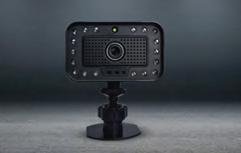
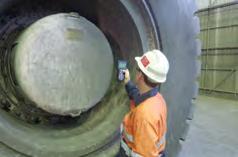
CABSENSE® DRIVER & OCCUPANT BEHAVIOUR MONITORING SYSTEM
Driver and Fatigue (Distraction) and behavioral Monitoring System with live In-Cabin alerts with integration and remote monitoring by LSM- FSM® Telemetry System.
COLLISION AVOIDANCE SYSTEMS
ISO 5006 / 16001 compliant Camera Viewing and Radar Proximity Detection Solutions for all applications for increased Safety, Equipment Damage Control and Productivity. Integration and remote monitoring by FSM® Telemetry System.


XLR® POWERED ENGINE AIR IN-TAKE PRECLEANER & PRE-FILTRATION TECHNOLOGY
World’s first and only XLR™ (Extra Low Restriction) Engine Air In-take Powered Precleaner and Pre-Filtration Technology. integration and remote monitoring by FSM® Telemetry System.
FLEET SAFETY & MAINTENANCE (FSM®) TRACKING MANAGEMENT / TELEMETRY SYSTEM
OH&S Regulators, Authorities and Industry Leaders are calling to mandate Safety Engineering Controls and respective telematics. FSM® secures your data, is integrated into our mitigation technology’s and will assist with significant cost-downs and proof of compliance.
